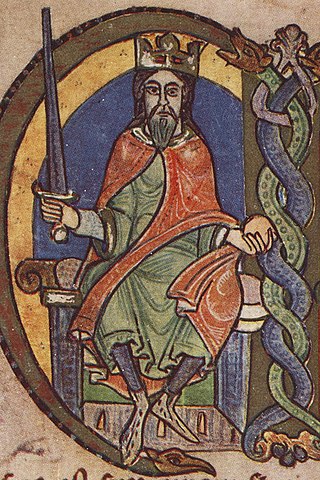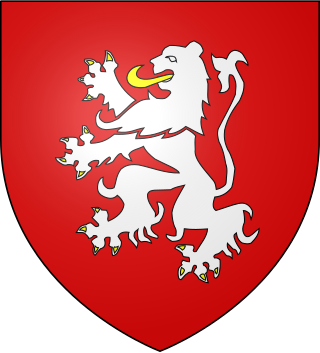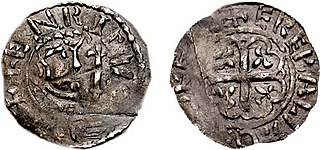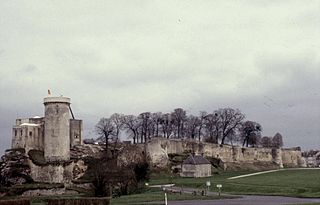Related Research Articles

Stephen, often referred to as Stephen of Blois, was King of England from 22 December 1135 to his death in 1154. He was Count of Boulogne jure uxoris from 1125 until 1147 and Duke of Normandy from 1135 until 1144. His reign was marked by the Anarchy, a civil war with his cousin and rival, the Empress Matilda, whose son, Henry II, succeeded Stephen as the first of the Angevin kings of England.

Year 1153 (MCLIII) was a common year starting on Thursday of the Julian calendar.

Year 1136 (MCXXXVI) was a leap year starting on Wednesday of the Julian calendar.

Empress Matilda, also known as the Empress Maude, was one of the claimants to the English throne during the civil war known as the Anarchy. The daughter and heir of Henry I, king of England and ruler of Normandy, she went to Germany as a child when she was married to the future Holy Roman Emperor Henry V. She travelled with the emperor to Italy in 1116, was controversially crowned empress in St Peter's Basilica, and acted as the imperial regent in Italy. Matilda and Henry V had no children, and when he died in 1125, the imperial crown was claimed by his rival Lothair of Supplinburg.

The Anarchy was a civil war in England and Normandy between 1138 and 1153, which resulted in a widespread breakdown in law and order. The conflict was a war of succession precipitated by the accidental death of William Adelin who drowned in the White Ship disaster of 1120. Henry sought to be succeeded by his daughter, known as Empress Matilda, but was only partially successful in convincing the nobility to support her. On Henry's death in 1135, his nephew Stephen of Blois seized the throne, with the help of Stephen's brother Henry of Blois, who was the bishop of Winchester. Stephen's early reign saw fierce fighting with disloyal English barons, rebellious Welsh leaders, and Scottish invaders. Following a major rebellion in the south-west of England, Matilda invaded in 1139 with the help of her half-brother Robert of Gloucester.

David I or Dauíd mac Maíl Choluim was a 12th-century ruler and saint who was Prince of the Cumbrians from 1113 to 1124 and later King of Scotland from 1124 to 1153. The youngest son of Malcolm III and Margaret of Wessex, David spent most of his childhood in Scotland, but was exiled to England temporarily in 1093. Perhaps after 1100, he became a dependent at the court of King Henry I of England, by whom he was influenced.

The Battle of the Standard, sometimes called the Battle of Northallerton, took place on 22 August 1138 on Cowton Moor near Northallerton in Yorkshire, England. English forces under William of Aumale repelled a Scottish army led by King David I of Scotland.
Geoffrey Rufus, also called Galfrid Rufus was a medieval Bishop of Durham and Lord Chancellor of England.
Matilda was Countess of Boulogne in her own right from 1125 and Queen of England from the accession of her husband, Stephen, in 1135 until her death in 1152. She supported Stephen in his struggle for the English throne against their mutual cousin Empress Matilda. She played an unusually active role for a woman of the period when her husband was captured, and proved herself an effective general who managed to force the Empress to release Stephen. Under the agreement that settled the civil war, the Queen's children did not inherit the English throne; however, her three surviving children ruled Boulogne in turn as Eustace IV, William I, and Marie I.

Ranulf II, 4th Earl of Chester (1099–1153), was an Anglo-Norman baron who inherited the honour of the palatine county of Chester upon the death of his father Ranulf Meschin, 3rd Earl of Chester. He was descended from the Counts of Bessin in Normandy.

Henry of Scotland was heir apparent to the Kingdom of Alba. He was also the 3rd Earl of Northumbria and the 3rd Earl of Huntingdon. He was the son of King David I of Scotland and Queen Maud, 2nd Countess of Huntingdon.

The Treaty of Falaise was a forced written agreement made in December 1174 between the captive William I, King of Scots, and Henry II, King of England.

Robert I de Brus, 1st Lord of Annandale was an early-12th-century Anglo-Norman lord and the first of the Bruce dynasty to hold lands in Scotland. A monastic patron, he is remembered as the founder of Gisborough Priory in Yorkshire, England, in present-day Redcar and Cleveland, in 1119.

The relationship between the Kingdom of England and King David I, who was King of Scotland between 1124 and 1153, was partly shaped by David's relationship with the particular King of England, and partly by David's own ambition. David had a good relationship with and was an ally of Henry I of England, the King who was largely responsible for David's early career. After Henry's death, David upheld his support for his niece, the former Empress-consort, Matilda, and expanded his power in northern England in the process, despite his defeat at the Battle of the Standard in 1138.

Nigel was an Anglo-Norman clergyman and administrator who served as Bishop of Ely from 1133 to 1169. He came from an ecclesiastical family; his uncle Roger of Salisbury was a bishop and government minister for King Henry I, and other relatives also held offices in the English Church and government. Nigel owed his advancement to his uncle, as did Nigel's probable brother Alexander, who like Nigel was advanced to episcopal status. Nigel was educated on the continent before becoming a royal administrator. He served as Treasurer of England under King Henry, before being appointed to the see, or bishopric, of Ely in 1133. His tenure was marked by conflicts with the monks of his cathedral chapter, who believed that Nigel kept income for himself that should properly have gone to them.
The first treaty of Durham was a peace treaty concluded between kings Stephen of England and David I of Scotland on 5 February 1136.
William Cumin was a bishop of Durham, and Justiciar of Scotland.
Events from the 1130s in England.

The siege of Wark is a 1138 siege of Wark on Tweed Castle conducted from May–November by Scottish forces under David I against the defending English garrison. The siege was part of a campaign launched by David in support of his niece, the Empress Matilda, and her claim to the English throne over that of Stephen of Blois who had seized the throne in 1135. The invasion followed a similar campaign in 1136 when David had succeeded in gaining control of Cumberland, and raids launched in 1137 and earlier in 1138.
References
- ↑ Blanchard, Ian (2001). Mining, Metallurgy and Minting in the Middle Ages: Afro-European supremacy, 1125-1225. Franz Steiner Verlag. p. 632. ISBN 978-3-515-07967-9.
- ↑ Patterson, Robert (1 July 1989). Haskins Society Journal Studies in Medieval History: Volume 1. A&C Black. p. 92. ISBN 978-0-8264-3027-4 . Retrieved 23 February 2024.
- ↑ Young, Alan; Research, Borthwick Institute of Historical (1978). William Cumin: Border politics and the Bishopric of Durham, 1141-1144. Borthwick Publications. p. 9. ISBN 978-0-900701-46-7.
Bibliography
- Howlett, Richard (ed.): "The Cronicles of Richard, Prior of Hexham" (Chronicles of the Regin of Stephan, Henry II., and Richard I, vol. 3, p. 2) London (1964), pp. 177-178